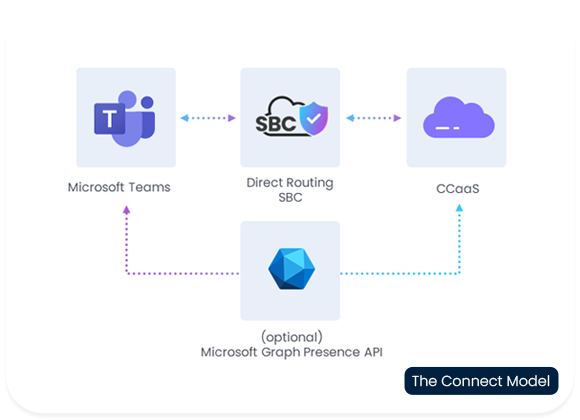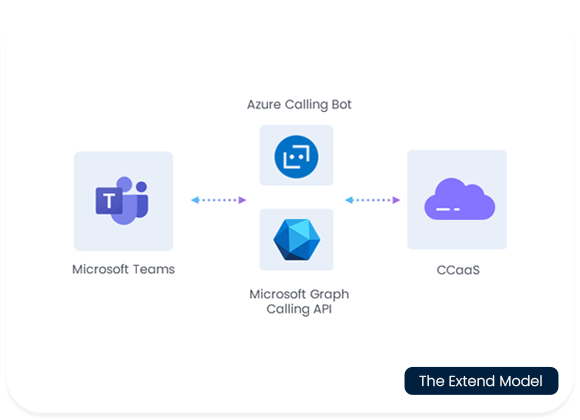Typically, an organization’s contact center solution is in a silo. Living aside from the organizational PBX and relying on people like you to manage the two separate communication platforms. This separation manifests in a few challenges, leading to poor customer and employee experiences.
Some key challenges and issues arise from this separation:
Fragmented Communication Tools
Only the traditional agents in the contact center have access to IVR, queuing, reporting or other contact center capabilities. Other employees within the company are limited to basic PBX functionalities such as basic call routing, hunt groups and voicemail.
Increased Security Risks
Separate infrastructures require their own dedicated maintenance, access and security handling. This setup requires organizations to have network protection from threats originating through two sources: the PBX and the contact center. This is asking for trouble.
Disruption in the Customer Experience
The service workflow is disjointed. If a call to a traditional agent needs to be escalated to a back-office expert or internal agent, the transfer is blind and results in the loss of important data and reporting associated with the call. The back-office expert or internal agent may not have access to the call history, customer information or any notes made by the contact center agent, which hampers their ability to provide quick, personalized service.
Life After Consolidation
Contact center integration presents an exciting opportunity to leverage Microsoft Teams as the vessel for a contact center. Research experts, Gartner, mention this in a recent report, “How and When to Use a Contact Center in Microsoft Teams” 1
When you deploy a contact center solution on top of Teams, every Teams user becomes a potential agent.
This is especially relevant for departments beyond the contact center, which provide internal and external-facing services too.
For example:
- IT Helpdesk
- Sales teams
- HR desks
- Security teams
- Legal team
- Travel desks
We refer to the people who sit in these departments as internal agents.
Departments Beyond the Contact Center Benefit from CCaaS Capabilities
Consider the scenario of a call coming into the sales department outside of regular working hours, is the possibility of missing that lead worth it? Or imagine a situation where a potential candidate for a critical role calls on a Saturday morning, could directing that call to a recruiters’ cell phone be a more suitable solution? And don’t forget the constant availability requirement of teams like security or the travel desk, how are you addressing their needs for 24/7 support?
Users situated within these departments provide ongoing service to individuals in and out of the organization. Now they can leverage CX capabilities like intelligent routing, after-hour call handling, IVR, queuing and reporting.
When you have a contact center as a service (CCaaS) that rides Teams, those capabilities are available to every user in your company – and this is the real power of Teams and contact center integration.
The 3 CCaaS Integration Models for Microsoft Teams
Organizations face hurdles when they try to combine elements designed in different eras, and with different connectivity methods.
Microsoft offers three models to integrate contact centers with Microsoft Teams: the Connect, the Extend and the Power models.
➊
The Connect Model
According to Microsoft, “The Connect model uses Microsoft certified SBCs and Direct Routing to connect contact center solutions to Teams phone system infrastructure, enabling enhanced routing, configuration and system insights.”
This is a viable integration model if you are looking to connect with Teams through an SBC and Direct Routing.
You’ll be able to see when agents are available in Teams, use Office 365 authentication for agents to connect with their Teams tenant, transfer and group calls with Teams, and use Graph APIs and Cloud Communication APIs for integrations with Teams.
Depending on your use case, the Connect model may entail few challenges:
- Your Microsoft Teams and contact center environments are separate and isolated
- Calls connect over a blind SIP transfer
- Use Graph API for presence-based routing, with throttling limitations
- Calls and media are handled outside of Microsoft Teams
- Reports are glued together from multiple sources of data (contact center and Microsoft Teams)

➋
The Extend Model
Microsoft states, “The Extend model uses the Teams phone system for all contact center calls and call control experiences, and the contact center solution provider acts as a telephony carrier alongside Microsoft 365.”
The Extend model is a big step forward from the Connect model, namely in how it integrates with Microsoft Teams Phone. Contact center calls are brought into Microsoft Teams over Graph API, and optionally via Microsoft Calling Plans or Operator Connect, with full call media handling within the Microsoft Teams ecosystem.
Organizations can design workflows and advanced routing configurations down to the individual and measure the quality of their system and interactions, with full visibility of agents and other Teams users' availability and 100% authentic reporting data arriving from a single calling source.
Key challenges associated with the Extend model are related to both infrastructure as well as UI flexibility and consistency of the agent experience.
The Extend model relies on Graph API for presence and Microsoft Teams Phone as the core calling and routing elements for the contact center solution. Some vendors are also utilizing the Azure Calling Bot to leverage Microsoft Calling Plans or Operator Connect.
This architecture may introduce additional routing paths and latency associated with the multiple underlying infrastructure elements, resulting in the accuracy and responsiveness of real-time routing data.
Additionally, the Extend model entails using a Microsoft Teams-native application only. This presents difficulties in creating a fully flexible UI and in ensuring a consistent agent and supervisor application experience across multiple devices, operating systems or screens (for example: CRM screen, iOS/Android, Desktop Web, Mobile Web, etc.).
Highlights of the Extend Model:
- CCaaS on top of Microsoft Teams Phone infrastructure
- The call is handled purely within the Microsoft Teams ecosystem
- Azure Calling Bot for Microsoft Calling Plans & Operator Connect
- Single source of call data
- Multiple real-time API interactions

➌
The Power Model
Microsoft lists, “The Power model enables solution providers to create native Azure-based voice applications using the Teams calling infrastructure and client platform to deliver modern, intelligent solutions for collaborative customer and agent connection.”
The Power model is the tightest integration between a CCaaS and Microsoft Teams.
This model allows a CCaaS to use an existing Microsoft Teams Phone infrastructure, just like the Extend model, while providing users with a dedicated, fully flexible and unified agent and supervisor application that acts as a natural extension to the user's Microsoft Teams client across multiple modalities (voice and digital channels) and communication types (external or internal).
Voice integration to Microsoft Teams is based on a native Azure voice application, which leverages Microsoft Teams Phone.
From an architecture standpoint, real-time routing decisions and event reporting are carried out with high accuracy and minimal time, with fewer routing decision elements and a significant reduction of API interactions.
This integration between a custom application built by a CCaaS vendor to Microsoft Teams, is achieved by leveraging a modern set of APIs and SDKs from Microsoft Azure Communication Services.
The Power Model Features:
- Microsoft Teams contact center on top of Azure Communication Services
- Calls are handled natively within the Microsoft Teams ecosystem
- Contact center agents' & supervisors' desktop UI is built as an extension to the Microsoft Teams Voice core
- Native call data and a single source of reporting
- Microsoft-grade media quality, encryption and security
- Direct connectivity to all the organization’s Microsoft Teams users

AudioCodes Voca Conversational Interaction Center Brings Modern Contact Center Capabilities to Microsoft Teams
AudioCodes Voca CIC, a lightweight CCaaS with built-in Conversational AI, is designed entirely for Microsoft Teams to unify your customer and employee experience.
With Voca CIC as a certified contact center solution for Microsoft Teams, you consolidate your unified communications and contact center into one-screen, allowing every Microsoft Teams user to become a potential agent.
Voca CIC is an Azure-native integration with Teams and offers a unique mix of contact center and voice expertise, making it an ideal solution for organizations looking to modernize their CX capabilities with minimal upfront costs.
Voca CIC brings CX capabilities to departments beyond the contact center and provides agents with real-time access to back-office experts to help improve responsiveness, remove department silos and improve connection among employees.
Try Voca CIC free for 30 days!
1 How and When to Use a Contact Center in Microsoft Teams, Gartner Report


